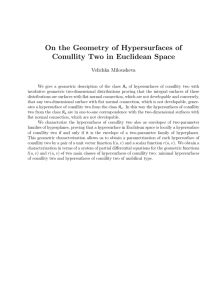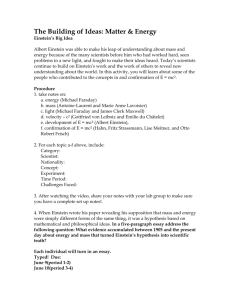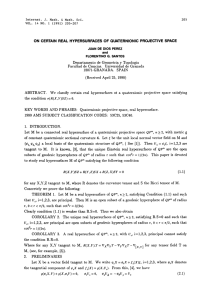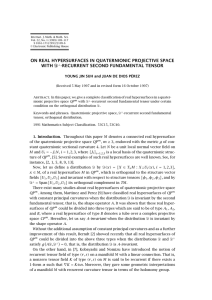Haven, HYPERSURFACES A CONFORMALLY FLAT SPACE
advertisement
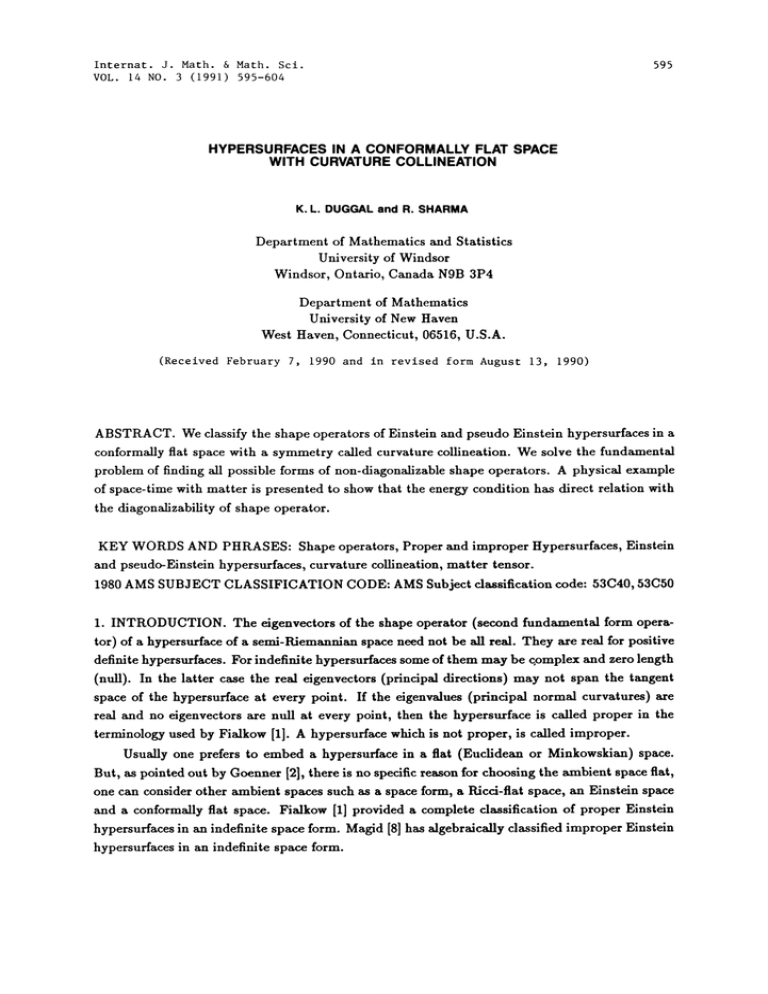
Internat. J. Math. & Math. Sci.
VOL. 14 NO. 3 (1991) 595-604
595
HYPERSURFACES IN A CONFORMALLY FLAT SPACE
WITH CURVATURE COLLINEATION
K.L. DUGGAL and R. SHARMA
Department of Mathematics and Statistics
University of Windsor
Windsor, Ontario, Canada NgB 3P4
Department of Mathematics
University of New Haven
West Haven, Connecticut, 0fi51fi, U.S.A.
(Received February 7, 1990 and in revised form August 13, 1990)
ABSTRACT. We classify the shape operators of Einstein and pseudo Einstein hypersurfaces in a
conformally flat space with a symmetry called curvature collineation. We solve the fundamental
problem of finding all possible forms of non-diagonalizable shape operators. A physical example
of space-time with matter is presented to show that the energy condition has direct relation with
the diagonalizability of shape operator.
KEY WORDS AND PHRASES: Shape operators, Proper and improper Hypersurfaces, Einstein
and pseudo-Einstein hypersurfaces, curvature collineation, matter tensor.
1980 AMS SUBJECT CLASSIFICATION CODE: AMS Subject classification code: 53(340, 53C50
1. INTRODUCTION. The eigenvectors of the shape operator (second fundamental form operator) of a hypersurface of a semi-Pdemannian space need not be all real. They are real for positive
definite hypersurfaces. For indefinite hypersurfaces some of them may be complex and zero length
(null). In the latter case the real eigenvectors (principal directions) may not span the tangent
space of the hypersurface at every point. If the eigenvalues (principal normal curvatures) are
real and no eigenvectors are null at every point, then the hypersurface is called proper in the
terminology used by Fialkow [1]. A hypersurface which is not proper, is called improper.
Usually one prefers to embed a hypersurface in a fiat (Euclidean or Minkowskian) space.
But, as pointed out by Goenner [2], there is no specific reason for choosing the ambient space fiat,
one can consider other ambient spaces such as a space form, a Ricci-flat space, an Einstein space
and a conformally fiat space. Fialkow [1] provided a complete classification of proper Einstein
hypersurfaces in an indefinite space form. Magid [8] has algebraically classified improper Einstein
hypersurfaces in an indefinite space form.
596
K.L. DUGGAL AND R. SHARMA
The aim of this paper is to present an Mgebraic classification of proper/improper Einstein
and pseudo Einstein hypersurfaces in a conformMly flat space. An exmnple of this space-time is
considered to show that the energy condition has direct relation with the diagonalizability of the
shape operator.
DEFINITION 1.1. (Katzin et al [4]). A vector field V in a semi-Pdemannian space is said
to generate a 1-parameter group of curvature collineations if it satisfies: LvR 0, where Lv and
R denote the Lie-derivative operator along V and the Riemann curvature tensor, respectively.
Curvature collineation (6"(7) is a fundamental symmetry [4] property of semi-Pdemannian
spaces. Indeed, it is known [4] that, for Ricci-flat spaces, more familiar symmetries such as
projective and conformal collineations (including affine collineations, motions, conformal and homothetic motions) are subcases of (76’. Physically, the well-known Komar’s covariant identity [8]
(which acts as a conservation law generator in general relativity) follows naturally as a necessary
condition for a 6’(7. Thus C’(7’s are necessarily embraced by the group of general curvilinear
coordinate transformations.
We, therefore, choose a conformally flat embedding space/r admitting a 1-parameter group
of (7(7’s. Our choice of the embedded space is a class of semi-Riemannian spaces defined as
follows:
DEFINITION 1.2. A semi-Riemmmian space is said to be pseudo-Einstein if there exists a
1-form u such that
Ric
xg + flu (R) u
(1.1)
and g(U,U) e(e
1); where g(U,X)= u(X), Ric denotes the Ricci tensor and x,r/are scalar
functions. For r/= 0, it reduces to an Einstein space.
The above definition is motivated by
(1) Yano’s definition [11] of a pseudo-Einstein hypersurface of a Kaehlerian space, given by equation (1.1) with X, r/as constmats.
(2) Einstein’s field equations in the framework of general relativity [4]
I
me+{^- }
+ ( + ) (R)
,
where p and/z re the pressure and energy densities of a perfect fluid, t is the 1-form metrically
equivalent to the velocity 4-vector U and A stands for the cosmological constant.
2. SHAPE OPERATOR OF EINSTEIN HYPERSURFACES. First we state the following result
of Katzin et al [5].
.
LEMMA 2.1. Let a vector field V generate 6"6" in an m-dimensional conformM1y flat space
with metric g. If
is a space form then V defines a motion (isometrr) for m _> 3 nd a
conformM motion for m 2. If
is not & space form then Lvg 2ag + TRi---’, where o" and
are scalr functions and Rc is the Pdcci tensor of ir.
r
r
Katzin et al [5,6] have shown that there are essentially only two types of conformally flat
spaces admitting proper 6"6’ viz. reducible and irreducible. In the reducible case Kx x K,_x
HYPERSURFACES IN A CONFORMALLY FLAT SPACE
597
(scMar curvature # 0) the metric is
d 2=ex(dz 1)+
/to
e(),
()
1-
where e’s e l,K0 is the constt curvature of K_ d upper ee inces run from 2 to
n. An example of such spaces is the Einstein Static Uverse. Moreover, the CC vector is
V
[V(z 1), Va(z,... ,z)] where V is bitry function of z other th az 1 + bz + e
and V a defines a motion in K,_. This mes that K_ is a toffy geodesic hypersurface of
K1 x K_. Thus we are motivated to sume that the tgentiM component of the CC vector
in
a
generates a motion in M.
As the ee when is space form, h been seussed in [9], we shM1 assume
space form in the subsequent discussions.
not to be
TEOREM 2.1. If an indefinite Einstein hypersurface M of dimension n 3, is embedded
adtting GG generated by a vector field whose
isometricMly into a conformy flat space
tangentiM component is Killing in M, then the shape operator A at each point of M is either
diagonMizable or
c
be put into one of the follong forms:
a
A
a
1
0
a
b
1
0 a
where a and b are arbitrary functions on M, with respect to some speciMly chosen basis. In the
last case, n is even and the signature of the metric of M is (n/2,n/2).
PROOV: A striaghtforward application of lemma 3.1 shows
Lvg
where V is the vector field generating CC in
normal part N as:
.
2og + TI
V
(2.3)
We decompose V int its tangential part and
(2.4)
+N,
N denoting the unit vector field (g(N,N)
+1) normal to M and f a scalar function on M.
Let us denote arbitrary vector fields tangent to M by X, Y, Z, W. Then eqn. (2.3) obtains
g(xV, Y) + g(yV, X)
7
2og(X,Y) + T--(X, Y),
denotes Levi-Civita connection of J/. Employing eqn.
formulae in the above yields
where
(Lg)(X, Y)
(2.4), Gauss and Weingarten
2ag(X, Y) + 2.fg(AX, Y) + TRic(X, Y).
(2.5)
K.L. DUGGAL AND R. SHARMA
598
As
is conformally flat, we have
[--(, )g(?, ) --(t, 2)g(?, )
+ g(?, 2)Ri(X, if’) g(X, )mc(Y, )]/(. Z)
g((t, ?)2, )
{/n(n- 1)}[g(]P,)g(’,)g(,])] (2.6)
The Gauss equation for M is
9(.(X, Y)Z, W) 9(R(X, Y)Z, W)
e{g(AY, Z)g(AX, W)
where A is the shape operator of M. Using it in
g(R(X,Y)Z, W)
g(AX, Z)g(AY, W)} (2.7)
(2.6) gives
[Ric(Y, Z)g(X, W) rtic(X,A)g(Y, W)
+ g(Y, Z)Ric(X, W) g(X, Z)mc(r, w)]/(n 1)
{e/n(n- 1)}[9(Y, Z)g(X, W)- g(X, Z)g(r, W)]
+ [a(AY, Z)a(AX, W) a(AX, Z)(AY, W)]
Now, if we substitute )
N and 17"
lTd
g((N,Y)Z,N)
Y, 2
z in
(2.8)
(2.6), then
[{Ric(N,N) (ee/n)}/(n
+ (/(. 1)Pdc(Y, Z).
)]g(Y, Z)
By the substitution X
W
e; where {e} is an orthonormal frame in M in eqn. (2.7),
and
by
multiplying
finally summing over i, we find
9(ei, ei)
ei
Ri---(Y, Z) eg(t(N, Y)Z,N)
Ri---(Y, Z) e{tr.A)g(AY, Z) g(AY, AZ)},
keeping in mind that { ei, N} constitutes an orthonormal frame in/r. Eliminating g((N, Y)Z, N)
from the last two eqns. gets
rue(Y, z)
Again, substituting Y
g
-
el,
r
By feeding eqn. (2.10)into (2.9)
Rie(Y, g)
{(n- 1)/(n- 2)}[mc(Y,Z)
+ {(enrti--7(N, N) e)/n(n 1)}g(y, z)
+ e{(tr.A)g(AY, Z) g(AY, AZ)}]
(2.9)
multiplying ei and then summing over i; in the above eqn. yields
2eRi--(g,N) e{(tr.A)
tr.A}.
(2.10)
we obtain
{(n )/(n 2)} [Rio(Y, Z) e{(tr.A)g(AY, Z) g(AY, AZ)}]
g(X,
Y)[(n
2(,=- 1)
2)(F/n)
,"
+ e((/r.A)
tr.A’)]
599
HYPERSURFACES IN A CONFORMALLY FLAT SPACE
Through eqn. (2.5) and the hypothesis that
generates motion in M,
we find
-(2.f /r)g(AY, Z) + pg(Y, Z)
Ric(Y, Z)
where p is a scalar function on M. A cumbersome computation using the last two equations
shows
Q
I + OA A
Q being defined by g(QX, Y)= Pat(X, r), and
enb
r
+ {2f(n 2)/(n 1)}tr.A e[(tr.A) 2
8
7tr.A
tr.A }
(2.13)
2ef(n 2)/(n 1)
Now, using the Petrov classification scheme [10] for symmetric tensors, A
form:
(2.11)
can be cast into the
nl
C1
where
di,i
0
di
di,,i
di
"’.
Bi
(di
"’.
+l)
di
di,,i
is an
(i x i)-matrix and
-
2tj)-matrix. As per our hypothesis, M is Einstein, i.e. O (r/n)I. Thus, eqn. (2.11)
implies that the orders of block matrices Bi and Cj are <_ 2. Consequently, A has blocks of type:
is a (2tj x
[,]o,
dAj
0
dj
dj
o
K.L. DUGCAL AND R. SHARPIA
600
or their combination. The second block can be
{e, ’}
{-e, ’}. Eventually, eqn. (2.11)
(er/n)I
transformed into
x,0 x,1
by change of the basis:
can be put as
I+0
M’atching corresponding entries we observe
0
(0
2Aj,
2ak)lk
0
(2.14)
where
(er/n) -$. If there are any blocks with/l’s (/5’s being non-zero) then a Aj 19/2,
for every j and k. Hence a’s and A’s are all equal to 0/2. From the last relation in (2.14) we also
observe that fl’s are rdl equal. Thus the relation-set (2.14) is equivalent to:
0=2A, 0=2c,
vi
(19 + V/(192
40))/2,
Obviously, A cannot have both a and A blocks, otherwise A
A-blocks then vi A and
A=
0
A 1
0 A
a
and/5t
tr.A
0. So, if A has only
nA
A 1
0 A
From A
0/2,
we
get tr.A
n19/2. Thus, in virtue of eqn. (2.15)
we find
e
2tr .A
2A
601
HYPERSURFACES IN A CONFORMALLY FLAT SPACE
2ef/(n- 1)T. Consequently,
A
a
1
0
a
1
0
a
"..
1
0 a
a
where a’r(t- 1)
2el. On the other hand, if A has only a-blocks then v a 4- V/(1 -2)
which cannot be real, because B # 0; and hence there cannot occur any v-term in A. Eventually,
we find that all a’s
0/2 and
A=
Thus, 0
2a
"-.
tr.A=na=n0/2.
a and
b
a
This completes the proof.
COROLLARY 1. Under the hypothesis of theorem 2.1, if M is improper then, either (A
aI) O, or (A- aI) -b:I, a, b being arbitrary functions on M and I the identity operator.
2
OPERATORS OF PSEUDO-EINSTEIN HYPERSURFACES. In this section we
study pseudo-Einstein hypersurfaces in the same context as of the pre,ceding section. We prove
3. SHAPE
the following theorem for 4-dimensional hypersurfaces only because it is cumbersome to consider
the blocks of the shape operator in higher dimensions.
THEOREM 3.1. If a 4-dimensional pseudo-Einstein hypersurface M4 is isometrically embedded into a conformally fiat space jr5 admitting CC generated by a vector field whose tangential
component generates motion in M4, then the shape operator A of M4 is either diagonalizable at
each point or can be put into one of the following forms:
a
A=
a
a
a
1
Oa
or
b
-b a
b
-ha
a
or
v
1
0
v
K.L. DUGGAL AND R. SHARMA
602
e2
where a,b,v and r/are scalar function on M4 and e
chosen basis.
1, with respect to some specially
PROOF: With respect to an orthonormal basis formed by U and three orthonormal vectors
orthogonal to U, we observe that the Ricci map can be represented by
z+er/
_
where e g(U, U) +1. Proceeding exactly as in the proof of theorem 2.1, up to eqn.
find that A has blocks of type
[]or
0
i
or
Therefore, either A will be diagonalizable at each point
(2.11) we
=
or can
be put into one of the following
forms:
v’
(1)
(3)
(2)
A 1
A1
1
0
’1
A2
0
1
A,
(4)
Plugging the above listed forms of A into eqn. (2.11) shows that the type (2) is not possible
whereas the types (3) and (4) hold only if M4 is Einstein which is taken care of by theorem 2.1.
The remaining type (1) leads to:
Thus, in this
case
A
Where v
v
1
0
v
0/2 and tr.A (8ef/3T) : V/(--ee/).
COROLLARY 2.. Under the hypothesis of theorem 3.1, if M is not Einstein then
either diagonalizable at each point or can be put in the form
A
v
1
0
v
A is
HYPERSURFACES IN A CONFORMALLY FLAT SPACE
603
with respect to some specially chosen basis.
We now interpret the physical significance of a pseudo-Einstein space in the light of the
above corollary. Einstein’s field equations of general relativity can be written in suitable units as:
1
T
Pdc +(^(3.1)
-r)g-
where T is the energy-momentum tensor of matter distribution. A comparison of eqn.(3.1) with
the defining eqn.(1.1) of a pseudo Einstein space, shows that
T
where p and # are given by
p
+ (p +p)u (R) u
1
p+-r-^=X,
p+p= r/
(3.3)
Eqn. (3.2) represents an isotropic matter of type [3] with energy density p and pressure p,
provided g(U, U) -1 (signature of M being + ++). It is remarkable to observe that such a
space is non-Einstein because otherwise we would get the non-physical state + p 0.
The signature of hr5 could be -++++ or --+++ only. If M has the former (Lorentzian)
-1 we have e -1. Hence V/(-er/) v/(p + p)
1. Moreover, since g(U, U)
signature then
which is always non-zero real (because # + p > 0). Thus, in this case either A is diagonalizable
at each point or
a
0
v
-+ + +, then we have 6 e -1, V/(-e)
which is always imaginary for physically realistic matter. Consequently, M is
proper. For this later case, the energy condition: p + p > 0, is equivalent to saying that M4 is
proper.
On the other hand, if the signature of jQ5 is
V/{-(p + p)}
4. EXAMPLE. Isometric embeddings of space-times has been used to obtain deeper insight into
the geometrical properties of the embedded space-time. This technique has also shed some light
on a number of global questions concerning singularities and causality properties. In particular,
several physically useful exact solutions have been found by the embedding technique, at least
for some cases of low embedding class [the maximum number of extra dimensions is called the
embedding class]. In fact, the maximal analytic extension of the Schwarzschild solution [3] was
found by the method of embedding.
In support of the above, we present an example of an isometric embedding of the type of
space-time described in this paper viz., 4-dimensional space-time of general relativity with an
isotropic matter of type I [3]. For details, we refer [71.
A 4-dimensional space-time is of embedding class 1 (i.e., a hypersurface) if there exists a
symmetric tensor fb satisfying:
e
4-1
(Gauss)
]abcd e(’acbd ’ad’bc),
fb;
fc;b
(Codazzi)
K.L. DUGGAL AND R. SHARMA
604
The field equations then yield (for A
Rab
0).
1
Tab + rgab
e( abCc
ae’
All possible tensors f corresponding to the isotropic matter or Maxwell type are known.
Precisely, there are four different cases (for details, see [7], pages 360-367). Here we mention the
following one case related to this paper:
ISOTROPIC PETROV TYPE 0 SOLUTION.
T
p
Relating this
(p + p)u (R) u + pg,
+p
case to the equations
1
2AB,
2AB > O,
p
(3.2) and (3.3)
Au (R) u + Bg,
f
3B >0,
we
x=2AB-3B
e
l
get
2+-r
andA=0
REFERENCES
1. A. Fialkow, Hypersur-faces o-f a space o-f constant curvature, Ann. of Math. 39 (1938), 762-785.
2. ’H.F. Goenner, Local isometric embedding o-f Riemannian manifolds and Etnstein’s theory o.f gravitation,
"General Relativity and Gravitation (one hundred years after the birth of Albert Einstein)," ed. A. Held,
1980, pp. 441-468.
3. S.W. Hawking and G.F.R. Ellis, The large scale structure o-f space-time, "Cambridge University Press,"
Cambridge, 1964.
4. G.H. Katzin, J. Levine ad W.R. Davis, Curvature collineations: A fundamental symmetry property o-f the
space-times o-f general relativity defined by the vanishing Lie-derivative o-f the Riemann curvature tensor, J.
Math. Phys. 10 (1969), 617-629.
5. G.H. Katzin, J. Levine and W.R. Davis, Curvature collineations in con-formally flat spaces I, Tensor, N.S.
21 (1970), 51-61.
6. G.H. Katzin, J. Levine and W.R. Davis, Curvature collineations in con.formally fiat spaces II, Tensor, N.S.
21 (1970), 319-329.
7. D. Kramer, H. Stephani, M. MacCallum and E. Herlt, Ezact solutions o-f Einstein’s Field Equations, "Cambridge University Press," Cambridge, 1980.
8. A. Komar, Covariant conservation laws in general relatity, Phys. Rev. 113 (1959), 934-936.
9. M.A. Magid, Shape operators o-f Einstein hypersur-faces in indefinite space -forms, Proc. Amer. Math. Soc.
$4 (1983), 237-242.
10. A.Z. Petrov, Einstein spaces, "Pergamon Press," Oxford, 1969.
11. K. Yano and M. Kon, CR submanifolda o-f Kaehlerian and Saaaldan manifolds, Birkhguser, Boston.
